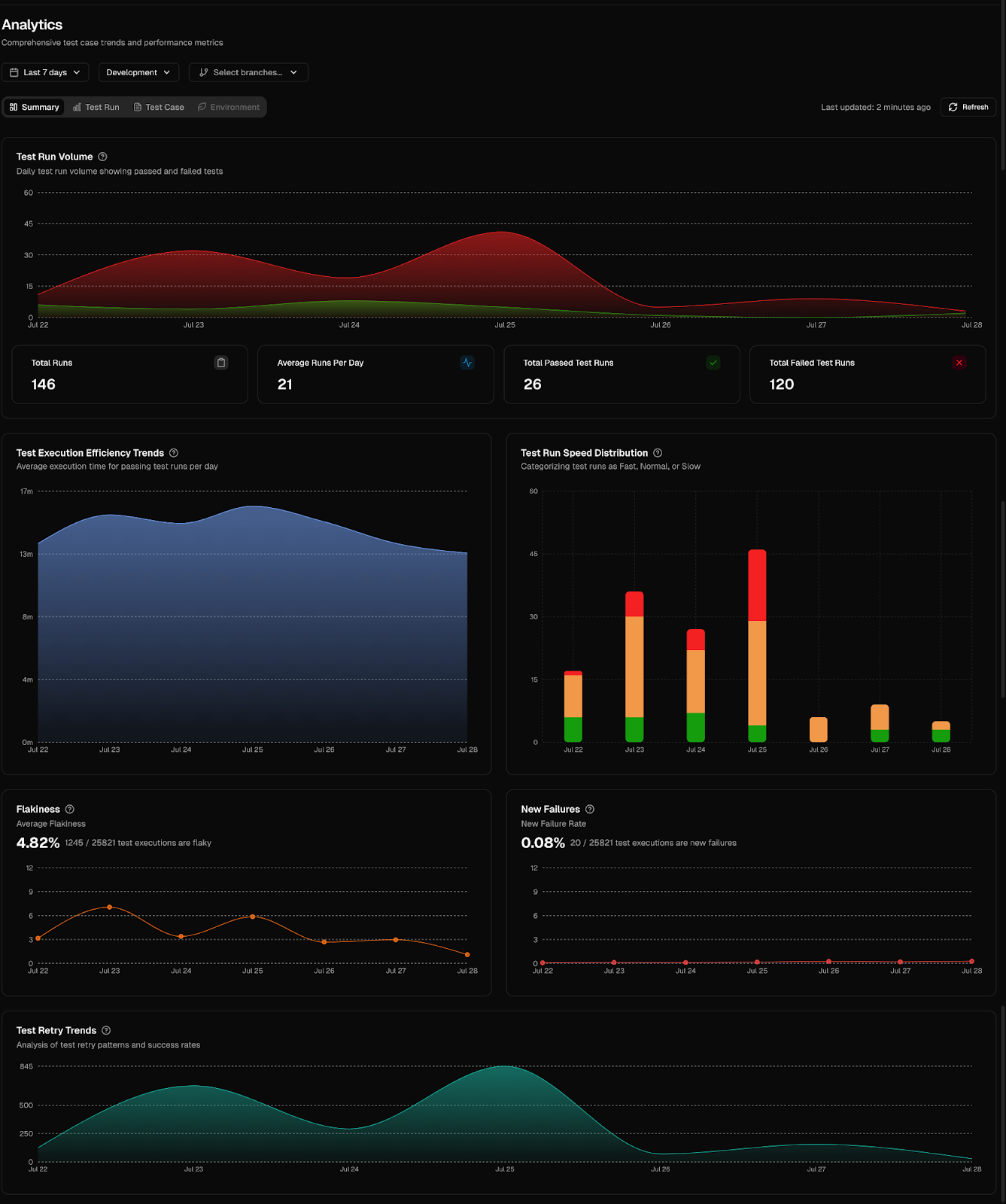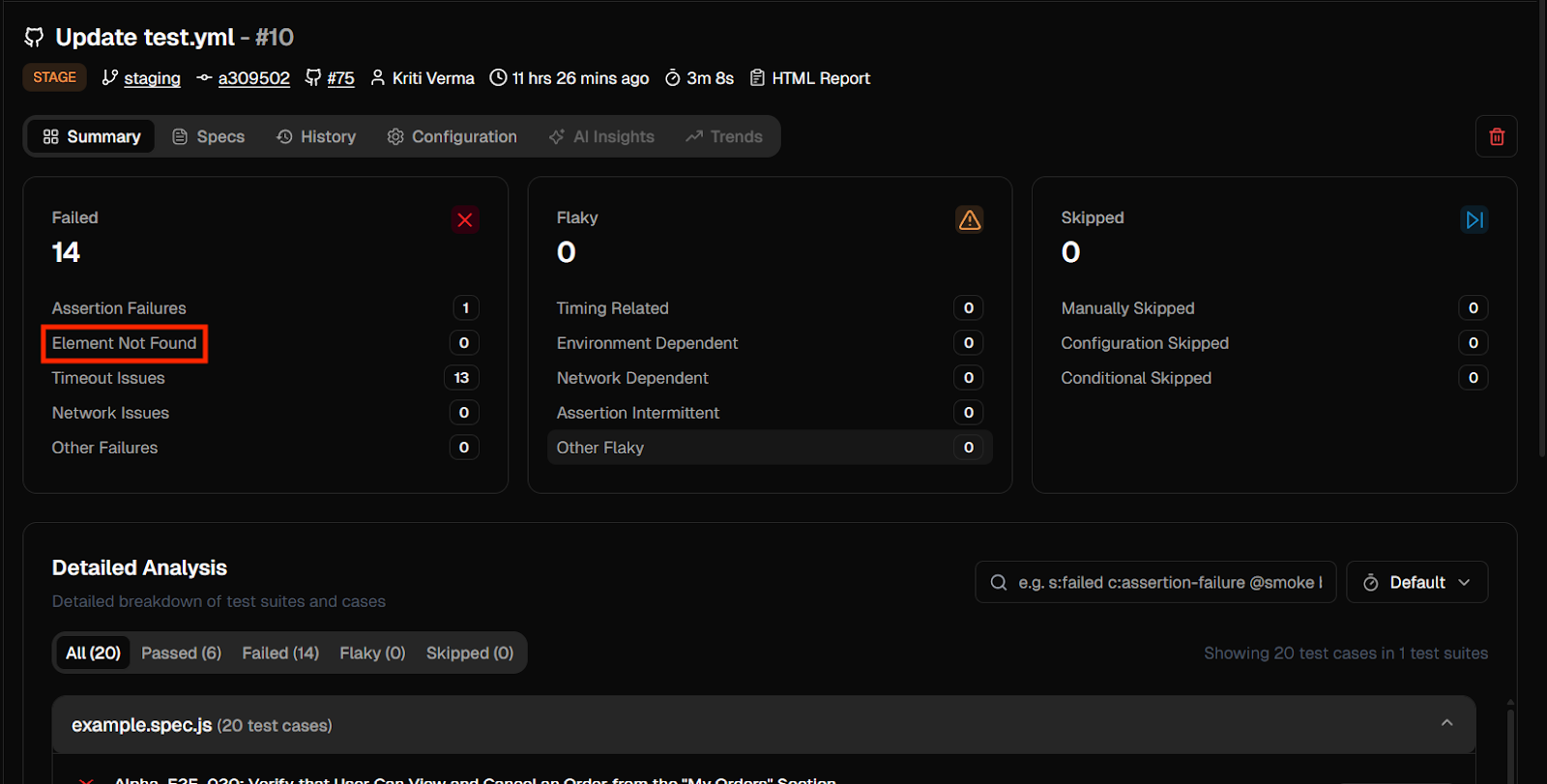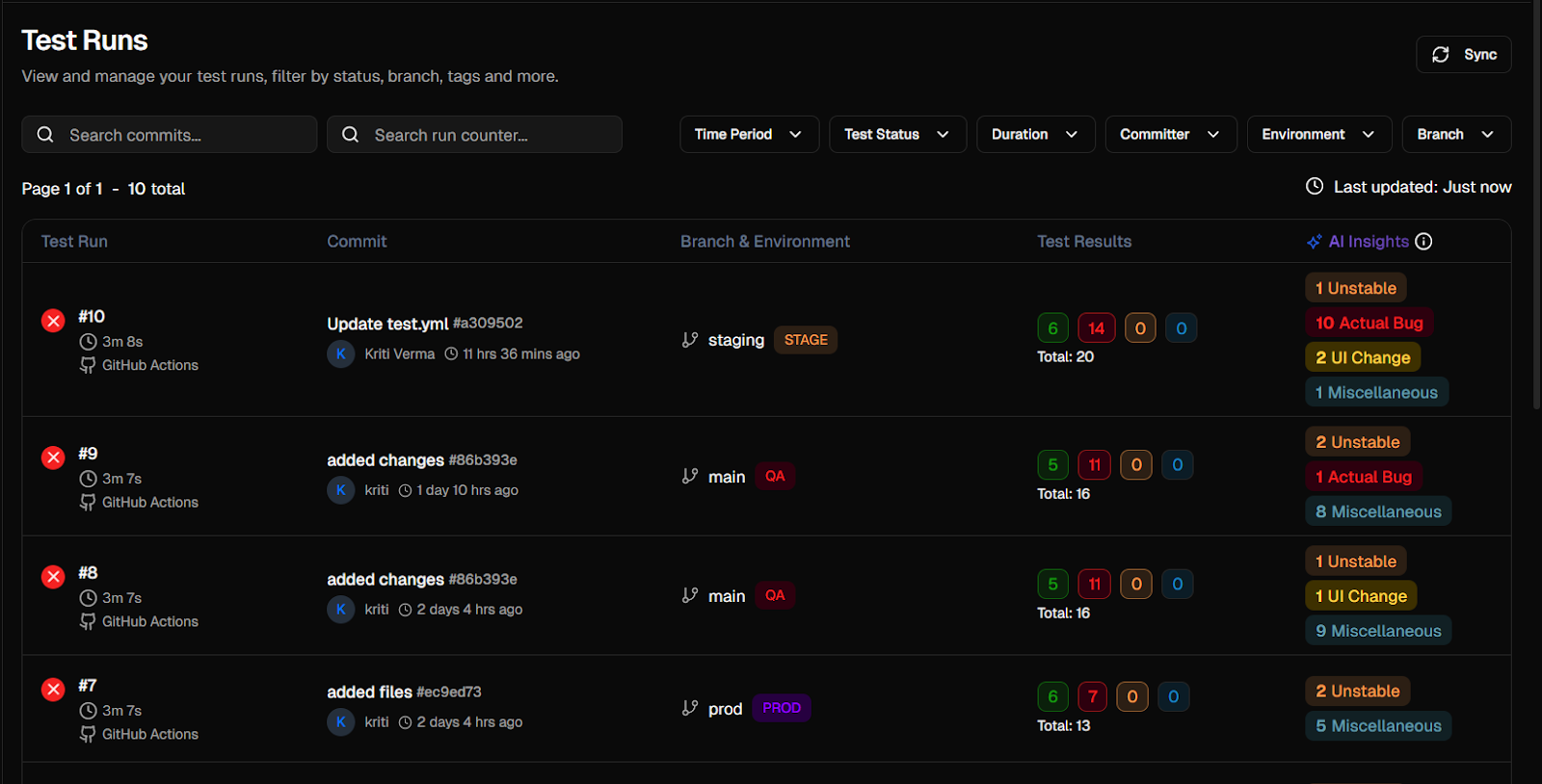It’s 2 AM. Your release just broke again. CI pipelines were green, tests appeared clean, and the dashboard looked harmless. Yet, staging is down, and no one knows why.
You're staring at static HTML reports and generic error logs. They show what failed, but give no clue why, no context, no trace, no help. It's like debugging in the dark. This is what outdated test reporting costs: lost hours, broken releases, and reactive firefighting when you should be sleeping or shipping.
Modern QA needs more than just pass/fail stats. It needs real-time test insights, flaky test detection, and root cause analysis that actually helps you fix the problem fast.
That’s where next-gen reporting tools step in. They track test execution patterns, highlight flaky behavior, and provide role-based views so developers, testers, and leads see what matters to them.
Among these, TestDino stands out. It uses AI to group failures smartly, alert teams live, and visualize data so clearly that debugging becomes a breeze even at 2 AM.
Let’s explore the top tools in 2025 redefining test reporting, and why smart teams are switching.
What is Test Reporting?
I love coffee, travel, and clean test reports. But unlike coffee, flaky test runs don’t get better with time; they just make your sprint planning worse.
We’ve seen teams try spreadsheets, screenshots, and console logs. Then they switch to the best test reporting software, and everything changes.
With today’s automated test reporting tools and QA test reporting tools, you're not just logging test outcomes, you’re unlocking visibility. Layer in CI/CD test reporting integration, and you’ve got real-time feedback for every pipeline run.
Need more than just pass/fail? Read how modern teams reduce noise with real-time test insight strategies that keep regressions in check.
Why Invest in Test Reporting Software?
Back when our team missed a production bug during a late Friday deploy, it wasn’t the test that failed; it was the report that didn’t tell the story.
That’s when we realized the need for clarity, not just coverage.
The best test reporting software surfaces patterns, not just logs. Tools like TestDino do this by:
- Grouping failures by root cause
- Detecting flaky tests in real-time
- Alerting you before users find the issue
Without intelligent reporting, teams waste hours digging through logs and rerunning tests. With platforms like TestDino, debugging becomes data-driven, focused, and visual.
If you’re serious about test velocity and accuracy, reporting isn’t optional; it’s foundational. See how ethical frameworks are shaping modern reporting in this post on QA, AI ethics, and fairness.
Key Selection Criteria
Why TestDino Checks All the Boxes
TestDino wasn’t just built for visibility, it was built for velocity. Whether you’re in a high-pressure CI/CD loop or managing hundreds of test scenarios daily, TestDino brings the context, speed, and precision that modern test teams demand.
With role-based dashboards, smart failure grouping, and AI-powered flaky test detection, it’s like having a test analyst baked into every pipeline run.
Turn Test Data Into Decisions—Visually and Instantly
Seeing test results is one thing. Understanding them is another. TestDino visualizes execution traces, failure clusters, and cross-browser behavior in real time so your devs aren’t hunting through logs at midnight.
From heatmaps to error timelines, every visual in TestDino tells a story where your test broke, why it broke, and what to fix next.
Top 9 Test Reporting Tools (Ranked)
1. TestDino: Playwright test reporter
Your tests passed, but staging crashed. Sound familiar? TestDino helps teams catch the why fast. With AI-powered insights, failure clustering, and trace-backed diagnostics, it turns noisy reports into clarity.
TestDino is built for speed and scale. Whether you're running 10 tests or 10,000, it visualizes trends, flags flaky failures, and aligns test outcomes with real engineering priorities.
This isn’t just another dashboard. It’s a test intelligence layer designed for developers, QA leads, and product owners to see what matters instantly.

This chart gives you a bird’s-eye view of test health across time tracking total runs, pass/fail ratios, and flaky behavior. It helps QA teams catch downward trends early and understand test load by environment or team.

Not all failures are equal. TestDino’s AI groups test failures based on root cause like timeouts, missing selectors, or API errors so you’re not wasting hours on redundant issues. One view, one fixed path.

Get full visibility into every test run stack traces, trace viewer, console logs, and execution steps. Whether it's debugging a flaky test or validating a fix, this detailed breakdown accelerates your QA loop.
2. ReportPortal
ReportPortal is an open-source test reporting dashboard that enables teams to visualize test execution across different frameworks. It helps track test failure trends and offers real-time feedback during test runs.
QA teams can analyze failed test scenarios, monitor flaky tests, and integrate with CI/CD workflows for smoother debugging. It also supports test retry strategy analysis through log-based insights.
While it supports various plugins and integrations, setting up test automation observability may require extra configuration. Teams looking to reduce test brittleness and manage fast execution browser contexts may need custom setups.
3. Allure TestOps
Allure TestOps offers a robust reporting layer that brings manual and automated test results into a unified dashboard. It enables QA teams to manage test execution, link test cases, and trace defects efficiently.
Its strength lies in helping teams track flaky tests and coordinate test scenarios across sprints. You can configure the test retry strategy and monitor cross-browser runs with support for Firefox and WebKit.
However, initial setup and integration into CI/CD systems can take time. Teams may require additional steps to capture execution traces and ensure stable test automation pipelines.
4. Extent Reports
Extent Reports is a popular HTML reporting library used to visualize test execution results in a customizable format. It works well with several test frameworks and offers detailed logs and screenshots for failed test scenarios.
It helps QA teams visualize test scripts, step-level breakdowns, and pass/fail trends. With proper setup, you can highlight test automation coverage and capture execution traces for failed cases.
However, it requires manual effort to integrate with CI/CD and lacks built-in support for flaky test detection or retry strategies. For teams scaling automation, they may need additional tools for test observability and cross-browser reporting.
5. TestRail
TestRail is a comprehensive test case management tool that also offers basic test reporting features for tracking manual and automated test execution. It’s known for its structured approach to managing test scripts, test scenarios, and test results across projects.
It integrates with CI/CD tools to help QA teams monitor test execution time and plan sprint testing.
Reports offer visibility but may lack the depth needed for debugging flaky tests or optimizing test retry strategies.
For teams heavily reliant on manual testing or planning hybrid QA strategy breakdowns, TestRail remains a reliable option, but for AI-powered insights or cross-browser test coverage, other tools may offer more advanced capabilities.
6. Zebrunner
Zebrunner is a modern test reporting and test automation tool designed for teams running high-volume test execution. It supports Playwright, Selenium, and Appium, making it a fit for teams testing web applications and mobile apps alike.
With visual reports, real-time dashboards, and flaky test detection, it helps reduce test brittleness and streamline debugging.
You can also configure test retry strategy and track failures across different environments, including modern browsers like Firefox and WebKit.
Zebrunner integrates well into CI/CD pipelines, helping teams gain visibility into parallel test execution and test execution time.
However, it may not offer the same level of AI-powered insights or role-based reporting as newer platforms built for 2025 QA workflows.
7. SpiraTest
SpiraTest is a comprehensive test management solution that includes features for requirements management, test case management, and defect tracking, alongside powerful reporting capabilities.
It integrates with various automation tools and is compatible with different Windows versions.
8. ReportNG
ReportNG is a simple, open-source test reporting tool often used with older Selenium test setups. It generates clean, HTML-based reports for test execution summaries.
It’s useful for lightweight projects but lacks modern test automation capabilities like test retry strategy or debugging flaky tests. It also doesn't integrate well with CI/CD tools or support modern browsers like Firefox and WebKit.
If you're aiming for cross-browser automation or stable test reporting pipelines, ReportNG might feel outdated for today’s end-to-end testing demands.
9. Katalon TestOps
Katalon TestOps brings structure to test reporting with organized dashboards, scheduling, and trend analysis features. It helps QA teams spot flaky tests, monitor test performance over time, and integrate seamlessly into CI/CD workflows.
But as test data scales and failures grow complex, traditional dashboards start to feel reactive. What modern teams crave now is predictive, role-aware intelligence not just summaries, but action-ready insights the moment tests fail.
{{cta-image}}
Playwright Flaky Test Handling Tools
How to Integrate with Your CI/CD Pipeline
I’m more of a systems geek. I love when things just click. The first time I saw our test execution pipeline kick off after a single Git push, it felt like magic, not just automation.
CI/CD test integration isn’t just about triggers. It’s about setting up:
- Fast test execution after each commit
- Smart test retry strategies
- Real-time feedback loops
Start by aligning your suite with your build logic and using Playwright test automation that supports modern browsers like Firefox and WebKit.
Speed matters, so spin up fast execution browser contexts to save every second.
As automation scales, it’s critical to think about responsible QA practices that ensure fairness and ethical standards across your pipeline, not just speed and efficiency.
{{cta-image-second}}
Best Practices
Conclusion
Modern QA isn’t just about writing test scripts; it's about building scalable, reliable test execution pipelines that adapt as your product grows. With Playwright and the right reporting tools, teams can achieve faster feedback, reduce flakiness, and gain deep visibility into their test scenarios.
At Alphabin, we help teams go beyond flaky test detection. Using AI-first tools like TestDino, our internal automation platform, enables you to configure test retry strategies, capture execution traces, and optimize for fast execution browser contexts across Firefox, WebKit, and more.
With TestDino, you’re not just tracking failures, you’re predicting them. It's AI-powered test reporting surfaces failure clusters, flaky test insights, and even suggests smart retry logic to keep pipelines green and fast.
You don’t need to fix everything at once. Start by stabilizing one flaky scenario. Add smart assertions. Track results. Then grow your pipeline with real-time alerts, CI/CD support, and actionable test insights.
Want test reporting clarity, not clutter? Talk to us. We’ll help you fix flaky Playwright tests fast.
FAQs
1. What causes flaky tests in Playwright?
Flaky tests often result from timing issues, dynamic content, test dependencies, or unhandled async behavior in test code.
2. Which test reporting tool is best for flaky tests?
TestDino stands out for flaky test reporting.It uses AI to auto-detect, group, and alert teams about flaky tests in real-time, improving CI stability.
3. Can I integrate these tools with CI/CD pipelines?
Yes, most tools like TestDino, Allure, Extent, and ReportPortal support integrations with Jenkins, GitHub Actions, GitLab CI, CircleCI, and others.
4. Are there free or open-source test reporting tools?
Yes. Tools like Allure, Mochawesome, and Robot Framework offer free, open-source reporting.
5. How do I debug flaky tests efficiently?
Enable trace viewer, use execution logs, and capture screenshots or videos for failed runs to trace root causes easily.



.svg)









.png)
